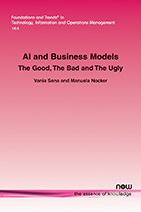AI and Business Models: The Good, The Bad and The Ugly
By Vania Sena, University of Sheffield, UK, v.sena@sheffield.ac.uk | Manuela Nocker, University of Essex, UK, mnocker@essex.ac.uk
Abstract
Over the last five years, several scholars from a range of disciplines have started to analyse how Artificial Intelligence (AI) affects businesses outcomes. This research effort has produced many predictions on the expected impact of automation on labour demand and equilibrium employment. However, most of the expected results are dependent on how businesses change their behaviour due to adopting AI. We argue that, as AI diffuses across the economy, changing behaviour is a necessary outcome for incumbents: the argument is that the diffusion of AI across an industry generates the conditions for a process of value migration from incumbents to new entrants (Helper et al. 2018); in these cases, the only mechanism available to incumbents to offset the negative impact of the migration process is by changing the architecture of their business, i.e., the business model. However, companies can choose from several AI-driven business models; their preference for one model is driven by many industry-level factors such as technical standards, the structure of the technology industry and the presence of an ethical framework for the use of AI. This monologue summarises the existing literature on business model innovation and AI; it then analyses the industry-level factors that may shape the business-level preference for specific business models. Finally, the monologue offers some suggestions for future research in the area.
AI and Business Models: The Good, The Bad and The Ugly
AI and Business Models summarizes the literature on AI and business model innovation. The main hypothesis is that the deployment of AI across an industry creates new mechanisms for value creation in an industry and in turn results in new firms generating value in an industry as incumbent firms may no longer be as competitive as in the past – the so called “value migration” phenomenon. Given the lack of data on AI, this monograph relies on qualitative studies as well as grey literature that underpins much of the research in the field. In this respect, a key purpose of the exercise is to identify where formal research is needed to help us to understand how business models change as the diffusion of AI across economies accelerates. Following an introduction, section 2 provides a brief introduction to AI and its different varieties. Section 3 focuses on value migration in an industry and business models. Section 4 provides a taxonomy of the new business models that have emerged as a result of AI and discusses the main features of these new business models. Section 5 analyzes the key factors that drive the emergence of new business models. Finally, Section 6 offers concluding remarks as well as reflections on existing gaps in our knowledge of business models that can inform future research in the field.
